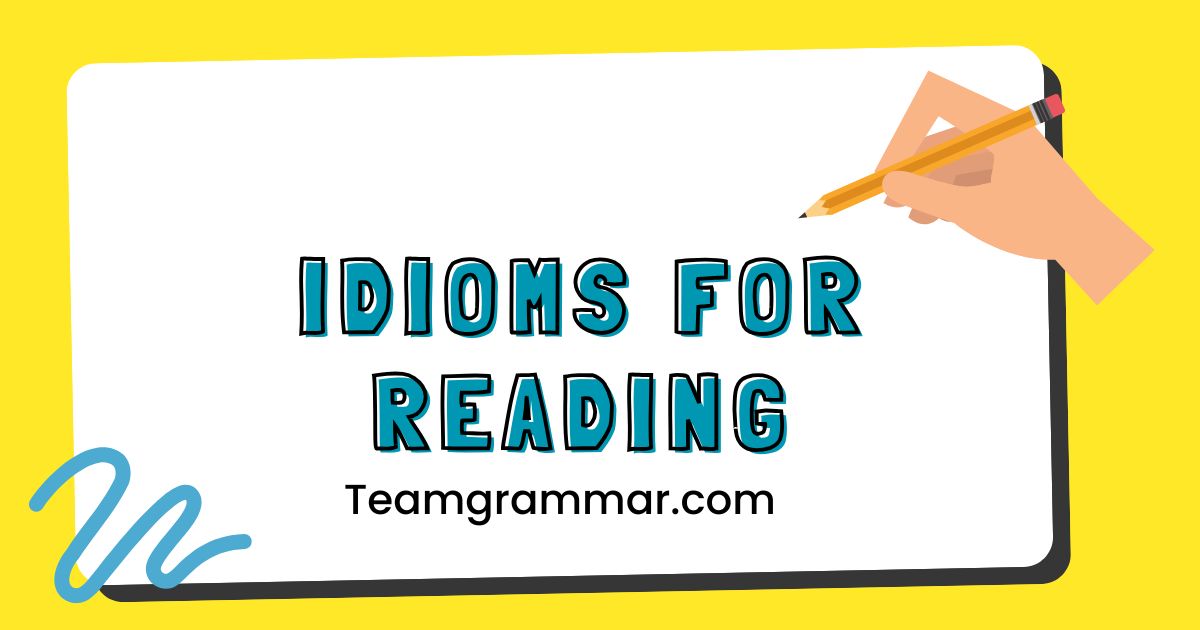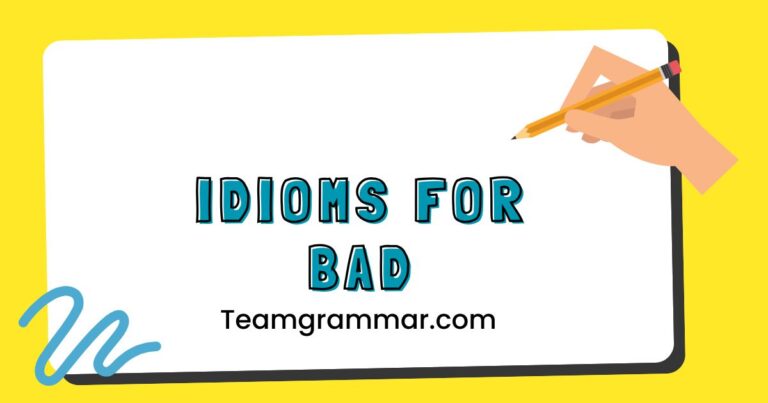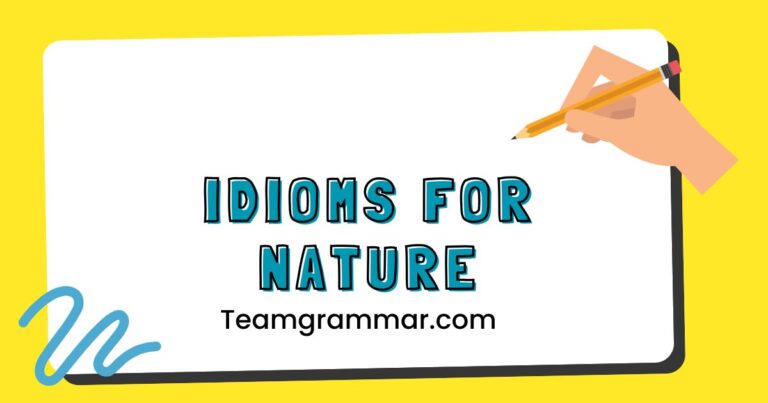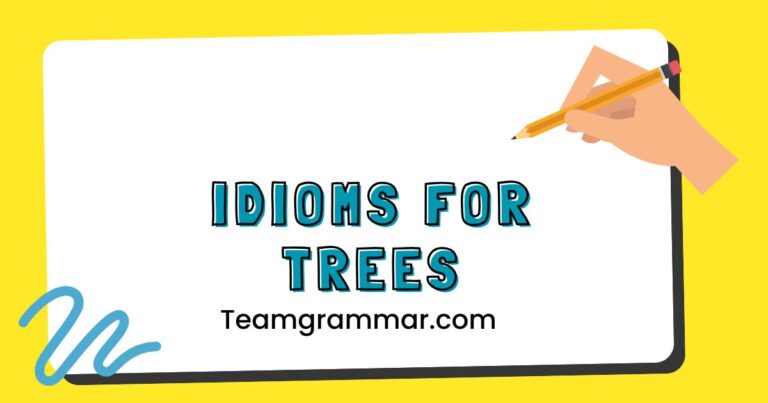29 Decoding the Page: Mastering Idioms for Reading Comprehension
Idioms are colorful expressions that add depth and flavor to the English language, but they can also be a significant hurdle for readers, especially non-native speakers. Understanding idioms is crucial for accurate reading comprehension, as their literal meanings often differ drastically from their intended meanings.
This article provides a comprehensive guide to idioms related to reading, covering their definitions, structures, usage rules, common mistakes, and practice exercises. Whether you’re an English language learner or simply looking to enhance your reading skills, this guide will equip you with the tools to navigate and interpret idiomatic expressions with confidence.
Table of Contents
- Introduction
- Definition of Idioms for Reading
- Structural Breakdown of Reading Idioms
- Types and Categories of Reading Idioms
- Examples of Idioms for Reading
- Usage Rules for Reading Idioms
- Common Mistakes with Reading Idioms
- Practice Exercises
- Advanced Topics in Reading Idioms
- Frequently Asked Questions
- Conclusion
Introduction
Idioms are a cornerstone of natural and fluent English communication. They are phrases or expressions whose meanings cannot be understood from the literal definitions of the individual words.
In the context of reading, idioms related to books, comprehension, and learning are particularly important. Comprehending these idioms allows readers to grasp the full meaning of texts, understand nuances, and appreciate the author’s intent.
This article is designed for English language learners, avid readers, and anyone seeking to improve their understanding of idiomatic expressions.
By mastering these idioms, you’ll not only enhance your reading comprehension but also enrich your overall understanding of the English language. This guide will break down complex concepts into manageable parts, provide numerous examples, and offer practical exercises to solidify your knowledge.
Let’s embark on this journey to unlock the hidden meanings behind common reading-related idioms.
Definition of Idioms for Reading
An idiom is a phrase or expression where the words used together have a meaning that is different from the dictionary definitions of the individual words. Idioms are a type of figurative language, relying on implied or symbolic meaning rather than literal interpretation.
In the context of reading, idioms often describe the act of reading, understanding texts, or related learning processes.
Classification: Idioms can be classified based on their syntactic structure (e.g., phrasal verbs, prepositional phrases) or their semantic function (e.g., metaphors, similes, hyperboles). Reading idioms often fall into the category of metaphorical expressions, where the act of reading is compared to something else to convey a deeper meaning.
Function:The primary function of idioms is to add color, emphasis, and cultural context to language. In reading, idioms can convey complex ideas concisely, add humor, or create a more vivid and engaging reading experience.
Understanding idioms is crucial for interpreting the author’s intended meaning and appreciating the nuances of the text.
Contexts: Reading idioms are commonly found in literature, academic texts, news articles, and everyday conversations about books and learning. They can be used to describe the difficulty of a text, the reader’s level of comprehension, or the overall impact of a book.
Structural Breakdown of Reading Idioms
Reading idioms, like all idioms, can vary greatly in their structural composition. They might consist of simple phrases, complex sentences, or even use rhetorical devices.
Understanding the structural elements can aid in recognizing and interpreting these idioms. Here’s a breakdown of common structural patterns:
Phrasal Verbs:Many idioms involve phrasal verbs, which combine a verb with a preposition or adverb. These combinations often have idiomatic meanings.
For example, “delve into” (to investigate thoroughly) uses the phrasal verb “delve into” to describe a deep reading process.
Prepositional Phrases: Some idioms are built around prepositional phrases. For instance, “between the lines” refers to understanding the implied meaning, and the prepositional phrase “between the lines” carries the idiomatic weight.
Metaphorical Comparisons: Many reading idioms use metaphors to compare the act of reading or understanding to something else. The structure often involves a comparison without using “like” or “as.” For example, “a page-turner” metaphorically compares a book to something that compels you to turn the pages quickly.
Similes: Similar to metaphors, similes use “like” or “as” to make a comparison. An example would be “read like a book,” suggesting someone is very easy to understand.
Types and Categories of Reading Idioms
Reading idioms can be categorized based on the aspect of reading they describe. Here are several categories:
1. Comprehension Idioms
These idioms describe the level or quality of understanding a reader has of a text.
2. Difficulty Idioms
These idioms refer to how easy or hard a text is to read and understand.
3. Engagement Idioms
These idioms describe how captivating or interesting a text is to a reader.
4. Speed Idioms
These idioms relate to the pace at which someone reads.
5. Learning Idioms
These idioms pertain to acquiring knowledge through reading.
Examples of Idioms for Reading
This section provides extensive examples of idioms related to reading, organized by category. Each example is accompanied by its meaning and a sentence showing its usage.
Table 1: Comprehension Idioms
The following table illustrates idioms that describe a reader’s level of understanding.
| Idiom | Meaning | Example Sentence |
|---|---|---|
| Read between the lines | Understand the implied meaning, not just the literal words | To understand the politician’s true intentions, you have to read between the lines. |
| Get the gist | Understand the main point or essence | I didn’t read the whole article, but I got the gist of it. |
| Take something at face value | Accept something as it appears, without deeper analysis | He took the article at face value without checking the sources. |
| Miss the point | Fail to understand the main idea | You completely missed the point of the author’s argument. |
| Grasp the nettle | Tackle a difficult task or understand a complex issue | To truly understand the theory, you have to grasp the nettle and delve into the equations. |
| See the forest for the trees | Understand the overall picture, not just the details | Sometimes, it’s important to see the forest for the trees when analyzing data. |
| Be on the same page | Have the same understanding or agreement | Before we proceed, let’s make sure we’re all on the same page. |
| In a nutshell | In a concise and brief summary | In a nutshell, the book is about the impact of technology on society. |
| Hit the nail on the head | State something exactly right | You hit the nail on the head with your analysis of the poem. |
| Get one’s head around something | Understand something complicated | I’m still trying to get my head around the complex plot of the novel. |
| Put two and two together | Infer something from the available information | After reading the clues, I was able to put two and two together and solve the mystery. |
| Not have a clue | Have no understanding at all | I don’t have a clue what the author is trying to say in this passage. |
| Make head or tail of something | Understand something confusing | I can’t make head or tail of this technical manual. |
| The penny drops | Suddenly understand something | After reading the explanation, the penny finally dropped. |
| Get the hang of it | Learn how to do something | It took a while, but I finally got the hang of reading ancient Greek. |
| Right up one’s street | Perfectly suited to one’s interests or abilities | That book is right up my street; I love historical fiction. |
| Go over one’s head | Be too difficult to understand | The lecture went completely over my head. |
| Know something inside out | Know something very well | She knows the history of the Roman Empire inside out after reading so many books on the subject. |
| Learn the ropes | Learn the basics of how to do something | It takes time to learn the ropes of academic writing. |
| A learning curve | The rate at which someone learns something new | There’s a steep learning curve when you start studying quantum physics. |
| In black and white | In writing, clearly stated | The rules were in black and white, so there was no excuse for not following them. |
| Get the message across | Communicate something effectively | The author got the message across very clearly in the final chapter. |
| Barking up the wrong tree | Pursuing the wrong course of action or idea | If you think that’s the main theme of the book, you are barking up the wrong tree. |
Table 2: Difficulty Idioms
This table presents idioms that describe the difficulty of reading a text.
| Idiom | Meaning | Example Sentence |
|---|---|---|
| Heavy going | Difficult to read or understand | The book was heavy going due to its complex language. |
| A tough nut to crack | A difficult problem or text to understand | This philosophical text is a tough nut to crack. |
| Clear as mud | Not clear at all; confusing | The instructions were clear as mud; I couldn’t understand them at all. |
| Hard to swallow | Difficult to believe or accept | The author’s conclusions were hard to swallow, given the evidence. |
| Like wading through treacle | Very slow and difficult | Reading this report is like wading through treacle. |
| Double Dutch | Incomprehensible language | The technical jargon in the manual was double Dutch to me. |
| Greek to me | Incomprehensible; impossible to understand | This legal document is Greek to me. |
| Plain sailing | Easy and straightforward | Once I understood the basic concepts, the rest of the book was plain sailing. |
| A piece of cake | Very easy | The exam was a piece of cake after studying the material thoroughly. |
| Walk in the park | Very easy | Reading this novel was a walk in the park compared to the last one. |
| Get bogged down | Become overwhelmed or stuck in details | I got bogged down in the details and lost track of the main argument. |
| Lose the thread | Lose track of the main idea | I lost the thread of the story halfway through the chapter. |
| A dry read | Boring and uninteresting | The textbook was a dry read, but it was necessary for the course. |
| A page-turner | Very exciting and makes you want to keep reading | The mystery novel was a real page-turner. |
| Couldn’t put it down | Was so interesting that you couldn’t stop reading | The book was so captivating that I couldn’t put it down. |
| Keep up with | Stay at the same level or pace | It’s hard to keep up with all the new research in this field. |
| Fall behind | Fail to keep up | I fell behind on my reading assignments this week. |
| From cover to cover | Read every part of a book | I read the novel from cover to cover in one sitting. |
| Flick through | Read quickly, looking at only some parts | I flicked through the magazine while waiting for my appointment. |
| Skim through | Read quickly to get the main ideas | I skimmed through the report to get an overview of the findings. |
Table 3: Engagement Idioms
The following table includes idioms that describe how captivating or interesting a text is to a reader.
| Idiom | Meaning | Example Sentence |
|---|---|---|
| Hooked on | Addicted to; very interested in | I’m completely hooked on this series of novels. |
| Riveting | Extremely interesting and engaging | The historical account was riveting from beginning to end. |
| Kept me on the edge of my seat | Made me feel very excited, nervous, or interested about what was going to happen | The thriller kept me on the edge of my seat until the very last page. |
| Capture one’s imagination | Inspire or fascinate someone | The fantasy novel captured my imagination and transported me to another world. |
| Brought to life | Made vivid or real | The author brought the characters to life in her writing. |
| Lost in a book | Completely absorbed in reading | I was so lost in the book that I didn’t hear the phone ring. |
| A must-read | Something that is highly recommended to read | This book is a must-read for anyone interested in environmental issues. |
| Couldn’t put it down | Was so interesting that you couldn’t stop reading | The book was so captivating that I couldn’t put it down. |
| Food for thought | Something to think about | The article provided some interesting food for thought. |
| Tell tales | Narrate stories | The book tells tales of bravery and adventure. |
Table 4: Speed and Style Idioms
This table includes idioms that describe the pace at which someone reads.
| Idiom | Meaning | Example Sentence |
|---|---|---|
| Flick through | Read quickly, looking at only some parts | I flicked through the magazine while waiting for my appointment. |
| Skim through | Read quickly to get the main ideas | I skimmed through the report to get an overview of the findings. |
| Read at a snail’s pace | Read very slowly | He reads at a snail’s pace because he stops to look up every word. |
| Read like a book | Understand someone easily | I can read him like a book; I know exactly what he’s thinking. |
| Word for word | Exactly as written | The student recited the poem word for word. |
Usage Rules for Reading Idioms
Using idioms correctly requires understanding their specific meanings and contexts. Here are some key usage rules:
Context is Key: Always consider the context in which the idiom is used. The surrounding sentences and the overall tone of the text can provide clues to the idiom’s meaning.
Figurative vs. Literal:Remember that idioms should be interpreted figuratively, not literally.
If you try to understand the individual words in isolation, you’ll likely miss the intended meaning.
Cultural Awareness:Idioms are often culturally specific. What might be a common expression in one culture could be unfamiliar or nonsensical in another.
Be mindful of your audience and the cultural context.
Formality: Some idioms are more informal than others. Use formal idioms in academic or professional writing, and reserve informal idioms for casual conversations or less formal texts.
Verb Tense and Agreement: Ensure that the verb tense and subject-verb agreement are correct when using idioms. For example, if you’re referring to a past event, use the past tense of the verb in the idiom.
Common Mistakes with Reading Idioms
One of the most common mistakes is interpreting idioms literally. For example, someone might misunderstand “read between the lines” as actually looking at the physical space between lines of text.
Here are some further examples:
| Incorrect | Correct | Explanation |
|---|---|---|
| I got exact the gist of the article. | I got the gist of the article. | “Exact” is unnecessary and doesn’t fit the idiom. |
| He read between the lines literally. | He read between the lines. | The phrase ‘read between the lines’ is figurative; ‘literally’ contradicts it. |
| This book is a piece of pie. | This book is a piece of cake. | The correct idiom is “a piece of cake,” not “pie.” |
| She is under the book. | She is lost in a book. | The correct idiom to express absorption in reading is “lost in a book.” |
Practice Exercises
Test your understanding of reading idioms with these exercises.
Exercise 1: Fill in the Blanks
Choose the correct idiom from the list to complete each sentence.
- get the gist
- a tough nut to crack
- read between the lines
- a piece of cake
- heavy going
| Question | Answer |
|---|---|
| 1. The exam was ____ after I studied all week. | a piece of cake |
| 2. I didn’t understand all the details, but I ____. | got the gist |
| 3. This philosophical text is ____. | a tough nut to crack |
| 4. To understand the politician’s true intentions, you have to ____. | read between the lines |
| 5. The book was ____ due to its complex language. | heavy going |
| 6. It’s important to ____ to understand the author’s hidden message. | read between the lines |
| 7. The technical manual was ____ for someone without engineering experience. | heavy going |
| 8. Once you understand the basic concepts, the rest of the course will be ____. | a piece of cake |
| 9. Even though I didn’t read every word, I tried to ____ of the report. | get the gist |
| 10. Quantum physics is ____ for many students. | a tough nut to crack |
Exercise 2: Matching
Match each idiom with its correct meaning.
- Clear as Mud
- Page-turner
- Food for thought
- Lost in a book
- Hit the nail on the head
- a. Something to think about
- b. Not clear at all
- c. Very exciting and makes you want to keep reading
- d. State something exactly right
- e. Completely absorbed in reading
| Question | Answer |
|---|---|
| 1. Clear as Mud | b. Not clear at all |
| 2. Page-turner | c. Very exciting and makes you want to keep reading |
| 3. Food for thought | a. Something to think about |
| 4. Lost in a book | e. Completely absorbed in reading |
| 5. Hit the nail on the head | d. State something exactly right |
Exercise 3: Multiple Choice
Choose the best meaning of the idiom in the sentence.
| Question | Options | Answer |
|---|---|---|
| 1. I can’t make head or tail of this technical manual. | a) Understand it perfectly, b) Understand it a little, c) Cannot understand it at all | c) Cannot understand it at all |
| 2. After reading the explanation, the penny finally dropped. | a) Lost my money, b) Suddenly understood, c) Became confused | b) Suddenly understood |
| 3. The lecture went completely over my head. | a) I enjoyed it, b) I understood it perfectly, c) I didn’t understand it at all | c) I didn’t understand it at all |
| 4. He knows the history of the Roman Empire inside out. | a) Knows it a little, b) Knows it very well, c) Doesn’t know it at all | b) Knows it very well |
| 5. If you think that’s the main theme of the book, you are barking up the wrong tree. | a) Pursuing the correct idea, b) Pursuing the wrong idea, c) Planting a tree | b) Pursuing the wrong idea |
Advanced Topics in Reading Idioms
For advanced learners, exploring the origins and evolution of idioms can provide a deeper understanding. Many idioms have historical roots or cultural references that add layers of meaning.
For instance, researching the origin of “read between the lines” reveals its connection to cryptography and secret messages. Analyzing how idioms change over time and across different dialects can also be a fascinating area of study.
Furthermore, advanced learners can delve into the use of idioms in literature and rhetoric. Authors often use idioms strategically to create specific effects, such as humor, irony, or emphasis.
Analyzing these techniques can enhance your appreciation of literary works and improve your own writing skills.
Frequently Asked Questions
- What is the difference between an idiom and a metaphor?
An idiom is a phrase whose meaning is different from the literal meanings of its individual words, while a metaphor is a figure of speech that directly compares two unrelated things to highlight a similarity. All idioms are figurative language, however, not all metaphors are idioms. The key difference is that an idiom’s meaning is fixed and conventionalized, whereas a metaphor’s meaning is more flexible and context-dependent.
- How can I improve my understanding of idioms?
Read widely and expose yourself to different types of English texts. Pay attention to how idioms are used in context, and look up any unfamiliar expressions. Keep a notebook of new idioms you encounter, along with their meanings and example sentences. Practice using idioms in your own writing and conversations.
- Are idioms the same in all English-speaking countries?
No, idioms can vary significantly between different English-speaking countries and regions. Some idioms are common across all dialects, while others are specific to certain areas. Be aware of these regional variations when communicating with people from different backgrounds.
- Is it okay to use idioms in formal writing?
It depends on the specific idiom and the context of your writing. Some idioms are perfectly acceptable in formal writing, while others are too informal. Use your judgment and consider your audience when deciding whether to use an idiom in a formal setting. When in doubt, opt for more direct and literal language.
- How can I avoid misusing idioms?
Pay close attention to the context in which you encounter idioms, and make sure you understand their precise meanings. Avoid using idioms if you’re not completely sure of their meaning or usage. Consider asking a native speaker or language expert for feedback on your use of idioms.
- Can idioms be translated directly into other languages?
No, idioms usually cannot be translated directly into other languages because their meanings are figurative and culturally specific. A direct translation would likely result in a nonsensical or incorrect meaning. Instead, you need to find an equivalent idiom in the target language that conveys the same meaning.
- What are some resources for learning more about idioms?
There are many online dictionaries and resources dedicated to idioms, such as the Cambridge Idioms Dictionary, the Oxford Idioms Dictionary, and various websites that list and explain common idioms. You can also find books and textbooks that focus on idioms, as well as language learning apps that include idiom lessons.
- Why is it important to learn idioms for reading comprehension?
Idioms are frequently used in written English, and understanding them is crucial for accurately interpreting the author’s intended meaning. If you don’t understand the idioms in a text, you may miss important nuances, misunderstand the author’s tone, or even misinterpret the entire message.
- How do I identify if a phrase is an idiom?
A good start is to determine whether the phrase makes sense if interpreted literally. If it sounds strange or nonsensical when taken at face value, it’s likely an idiom. Also, consider the context. If the phrase seems out of place or doesn’t quite fit the surrounding text, it could be an idiom with a non-literal meaning.
- Are there any idioms that beginners should focus on learning first?
Yes, start with common idioms that appear frequently in everyday conversation and written texts. Some good examples include “get the gist,” “read between the lines,” “a piece of cake,” “in a nutshell,” and “on the same page.” Mastering these basic idioms will provide a solid foundation for learning more complex expressions.
Conclusion
Mastering idioms related to reading is essential for enhancing comprehension, appreciating nuance, and engaging more deeply with texts. This article has provided a comprehensive overview of reading idioms, covering their definitions, structures, usage rules, common mistakes, and practice exercises.
By studying these examples and following the guidelines, you can significantly improve your ability to understand and use idioms effectively.
Remember that learning idioms is an ongoing process. Continue to expand your knowledge by reading widely, paying attention to context, and practicing regularly.
With dedication and effort, you’ll become more confident in your ability to decode the hidden meanings behind idiomatic expressions and unlock the full potential of your reading skills.







